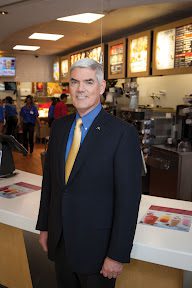Since Chris Lyons started working for McDonald’s Corp., there have been six United States presidents and four economic recessions. When he started in 1977, the drive-through window, now considered a traditional component of the fast-food dining experience, was still a novelty, and the “Happy Meal,” a product cherished by young McDonald’s customers around the world, was still two years away.
With that kind of history behind him, it made sense to throw his name into the ring four years ago when Maura Havenga, senior vice president of McDonald’s Restaurant Solutions Group, needed someone to fill the role of vice president of worldwide training, learning and development.
Lyons has been at the company for three decades, most of which was spent in operations management roles. In that time he said he has learned just about every detail of the operations side of running a McDonald’s franchise, from scheduling crew shifts to the costs of food ordering and running a series of restaurants efficiently.
Havenga said she would have been hard pressed to find someone with more gravitas to bring to the role.
“He’s been a line leader for so much of his career,” she said. “I mean, he’s had 35 years of experience. And with his operations background in franchise marketing, [Lyons] brings credibility to the role where he gets the business and he’s been accountable for results.
“He’s been accountable for top-line sales and bottom-line profitability, and he knows and understands what it feels like to take care of the customer. So, it’s not theory.”
He’s Lovin’ It
Credibility is a term McDonald’s has been able to hang its hat on throughout its history. Since its creation in 1940, former owner Ray Kroc slowly built an empire of cheeseburgers and milkshakes. McDonald’s has grown into a core American business, one that Wall Street analysts label among the most dependable for investors seeking steady growth.
In the last 10 years, McDonald’s stock price has climbed nearly 280 percent; it has grown 63 percent in the last three years alone. Analysts say its growth is due to its ability to adapt to consumer demands and penetrate global markets. As of the end of 2011, the company operated 33,510 restaurants in 119 countries, including 27,075 franchised restaurants and 6,435 that are company operated.
Lyons said McDonald’s focus on employee development is responsible for a large part of that success. Learning and development became a staple at the company early on. In 1961, Fred Turner, McDonald’s former senior chairman and Kroc’s first “grillman,” founded Hamburger University (HU) in the basement of a restaurant in Elk Grove Village, Ill. The idea was that the most highly developed talent would provide top quality and customer service, priorities McDonald’s has built its business on.
In February 1961, HU graduated its first class of 15 students. More than 80,000 restaurant managers, mid-managers and owner/operators have graduated from the university since then, and the facility now spans seven locations across the globe, including one at the corporate headquarters in Oak Brook, Ill., just outside of Chicago.
Its status as the world’s largest hamburger chain, hasn’t shielded McDonald’s from the headwinds created by a lagging domestic economy and currency pressures in Europe, where McDonald’s gets roughly 40 percent of its sales.
According to research reports by Brian Bittner and Michael Tamas, equity research analysts with Oppenheimer & Co., lower-than-expected sales results in Europe, Japan and China in recent quarters have presented the company with a fresh challenge — how to maintain its standing among global middle-class customers as austerity measures filter through Europe and U.S. consumers’ purse strings remain tight. Add in higher commodity costs thanks to this summer’s prolonged Midwestern drought — predicted to heavily impact food prices — and analysts say McDonald’s, like many global businesses, has its work cut out for it.
These challenges make learning and development more vital than ever to enable the organization to remain deeply connected to the fluid needs of the business, Lyons said. “Our best approach is to make sure that those managers running those restaurants are competent at their role, and then the moment of truth for us is the interaction with the customer,” he said. “… Even through these economic times we have continued to invest in and enhance our curriculum because we believe it is a big part of our success [going forward].”
“We have this mantra here within the Restaurant Solutions Group,” Havenga said. “It’s not real until it’s real in the restaurants. Chris brings value to the role as a business leader because he’s come up through the restaurants. That keeps him connected.”
Lyons became a manager trainee in Chicago in 1977 after graduating from Northern Illinois University with an undergraduate degree in business management. “I always say I learned the principles of management in school, but I really learned how to lead at McDonald’s,” he said.
Lyons went on to hold a number of field positions, including field service manager and operations manager. He then transferred into the corporate office, where he was named national franchising director. Lyons also served as a zone director and district manager for 225 company-owned restaurants in the Baltimore and Washington, D.C., region.
In 2000, Lyons was promoted to senior director, U.S. store systems; two years later he was named U.S. vice president of operations deployment. He then moved on to become an operations vice president for the greater Chicago area.
Most recently he served as the vice president for restaurant technology alignment, where he oversaw the reliability and operational requirements of McDonald’s store systems globally and worked with IT to time migration of key technology platforms.
In June 2008, he moved into the role of vice president of worldwide training, learning and development, with responsibility for the development of nearly every McDonald’s employee across the globe. “Learning has always been of interest to me,” Lyons said. “When I was in the field, I knew it was really a differentiating factor for McDonald’s and that our talent is our greatest resource.”
Hamburger U
McDonald’s uses a blended learning approach to reach its global workforce, and the company’s learning organization has created a developmental framework to influence employees to take responsibility for their own development.
The organization is also mindful of how learning is carried out in different markets. In some Asian markets, for instance, Lyons said McDonald’s restaurants offer its customers home delivery. Therefore, certain learning and development components have to be adjusted to provide proper training for these unique business needs. The same goes for other markets, as each has different product offerings and menu items unique to that region or country.
“The bottom line is it’s all about the customer,” Lyons said. “The customer walks up to the counter, pulls into the drive-through or gets a delivery. It’s about that customer, and we do the right things by having the right training materials for our people and allowing them the freedom within the framework to execute.”
Promoting autonomy factored into the recent redesign of McDonald’s mid-management training. Now field managers don’t have to take a trip back to Oak Brook to get trained — they can leverage technology to get learning materials and, in turn, teach people in their own restaurants.
Technology has enabled McDonald’s employees to get the exact training they need when they need it.
“It is not only more efficient, it is more relevant and impactful,” Havenga said. “… It’s much more timely. Before you’d be greatly dependent on budgets and timing, and for [a manager] to travel from China to [Oak Brook], it’s obviously time and expense — but more importantly, it’s much more current to when they need it.”
That hasn’t stopped Lyons’ travel, however. In the last 18 months, Havenga said Lyons had made at least two trips to China.
Yet the core of learning at McDonald’s remains with Hamburger University, which recently celebrated its 50th anniversary. The learning organization also embarked on a redesign and a re-think of its in-person classroom experience. No longer are classrooms at Hamburger University designed in lecture format; the physical redesign works to create a more collaborative, team-oriented environment.
To do this, Lyons said the company scrapped the traditional front and back of a conventional classroom. Desks morphed into tables with six seats around a large monitor, and each user at the table has the ability to plug in a laptop or other digital device as needed to accompany the learning experience. About three or four of these six-seat tables are interspersed throughout a room, which also has white boards and other digital monitors throughout.
Lyons said the design enables the instructor to walk about the room more freely, interacting with each of the learning teams as they work on business case studies and simulations, often without the need for paper since everything is digital.
“Even the boards in the room aren’t flip charts anymore,” Lyons said. “It’s really focused on that team interacting with each other and being able to work through business situations, business challenges together as a team. The team dynamic can happen right there at the table.”
Lyons said Hamburger University also now works in tandem with McDonald’s new Skinner Institute of Leadership, named after the firm’s former CEO and vice chairman, Jim Skinner, who retired in June after 41 years with the company. Former President Don Thompson succeeded Skinner as CEO.
Another primary component in McDonald’s learning organization is its College Credit Connection program. The company allows participating employees — many of whom have not attended college and started as crew members with the company — to apply coursework credits toward a list of colleges or universities of McDonald’s choosing. The college credit program is also available for those who work abroad.
Moving forward, Lyons said McDonald’s learning organization will continue to adapt to the evolving needs of its business — whether it’s adjusting to new marketing efforts in the wake of a new product launch or menu item, revamping learning delivery in markets based on new technologies, or implementing new in-restaurant technology that crew members and managers need to be brought up to speed on.
“From a technology point of view, we’ve always started with blended learning, but the need to ensure that we’re always incorporating the latest technology for the next generation [is also important],” Lyons said. “So there will be trials and test of different things in the markets as we develop things. … A lot of great learning comes from our field teams, so having those boards and groups that share best practices with each other is a way to make sure we have the right knowledge sharing sessions as much as possible.”
Lyons said it’s also important that he advance his own learning and development, a habit he picked up as a result of McDonald’s deep employee development heritage.
“I always stay curious. I love to learn,” he said. “… I think learning is more about what really drives people to excel, what makes them better at their job, what makes me better at my job. So [having] come up in an operations role, having a passion for this type of work and then the exposure and learning from my counterparts, it’s been fantastic … the different organizations that I’ve had the opportunity to be involved with has provided a tremendous learning experience for me.”
To see Chris Lyons and Diana Thomas of McDonald’s discuss how the company’s focus on customer service training has led to growth, click here.















